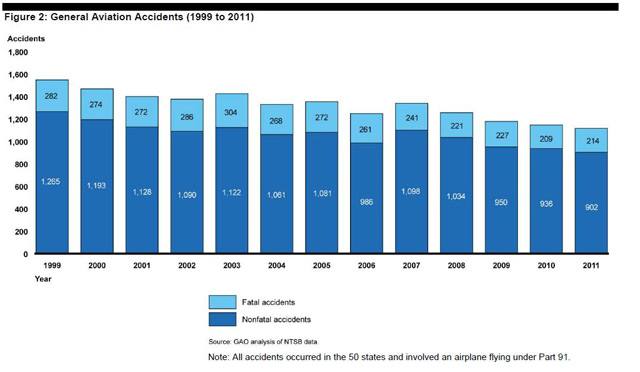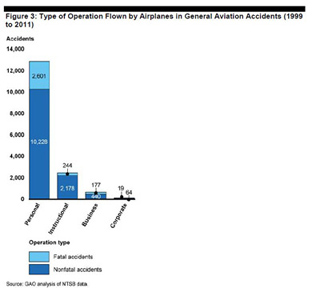
The General Accounting Office noted a slow decline in general aviation accidents that has been well documented, if not well understood.
While the number of general aviation accidents has slowly declined in the past decade, much remains unknown about the details. The Government Accountability Office (GAO), in an Oct. 4 report, called for the FAA to consider requiring aircraft owners to report hours flown—possibly in conjunction with annual inspections—and also called for a mandate for pilots to report recurrent training.
GAO staff analyzed NTSB data from 1999 to 2011, interviewed various government officials and industry stakeholders, and found that more information is needed before conclusions can be drawn about the root causes of general aviation accidents.
The GAO report itself contains many estimates. For example, the GAO analysis suggests that greater experience—more than 100 hours in make and model compared to fewer hours—may not result in increased safety, but the government has no data on hours flown between medical certificate applications, or which aircraft those hours were flown in.
 Personal aircraft flights have long been the most susceptible to accidents, but the root causes are complex, and often unclear.
Personal aircraft flights have long been the most susceptible to accidents, but the root causes are complex, and often unclear.
“For fatal accidents, 73 percent of pilots with fewer than 100 hours of experience in the accident airplane make and model were a cause as compared to 76 percent of pilots with more than 100 hours of experience,” the report states. It is unclear how those percentages were calculated. In about two-thirds of all fatal accidents there is no reliable data available on the pilot’s recent experience, or total time in the make and model of aircraft involved. Those details are not collected on the airman medical certificate application.
The GAO also questioned the ability of the FAA to realize a goal of reducing the GA accident rate by 10 percent by 2018 without having detailed information of overall hours flown. Figures on aircraft hours flown that government agencies use to calculate the rate of general aviation accidents come from an annual, voluntary survey.
The AOPA Foundation’s Air Safety Institute (ASI) has wrestled with these same issues for decades in producing the Joseph T. Nall Report, the twenty-second edition of which was recently released. Air Safety Institute Manager of Aviation Safety Analysis David Jack Kenny said the GAO report documents well-known trends, including the long-term decrease in the number of accidents and the disproportionate number that occur on personal flights (as distinguished from training, business travel by unpaid pilots, and corporate travel that is generally conducted by professional flight crews).
“Most of its recommendations deal with increased data collection rather than safety improvements per se, and ASI certainly agrees that any regulatory changes should be based on sound analysis of reliable data,” Kenny said. “However, we also believe that the government should provide specific and detailed justification before burdening pilots, owners, or operators with any additional reporting requirements.”
It is not clear to what degree mandatory reporting of aircraft and pilot hours flown, and pilot training, would shed light on many other factors that have long confounded efforts to identify and address root causes.
“The suggestions that pilots be required to disclose details of their annual flight activity and recurrent training and that mechanics report total aircraft hours at each annual inspection are not supported by a compelling explanation of how day-to-day operations would be improved by that information,” Kenny said.



